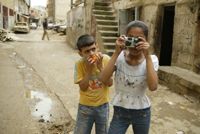Saturday, April 20, 2024
News and Views from the Global South
LEBANON: Children Look At The Brighter Picture
Mona Alami
- On the outskirts of Beirut, narrow alleyways cut through the Chatila Palestinian refugee camp. A maze of electricity cables connect one concrete block and another. Sewage pours continuously through a small grey construction, filling the street with nauseating stench.
They say that a picture is worth a thousand words, and that familiar idea motivated the Lebanese NGO Zakira to bring the art of photography to the children here.
It's another way of looking at a world of enormous piles of rubbish, where gunmen and fratricidal wars are common, and where a permanent state of lawlessness reigns. A group of Lebanese photojournalists now gives these children the opportunity to forget their surroundings through the world of photography.
Zakira's founder Ramzi Haidar, an AFP photographer, looked at violence while on assignment in Iraq through the eyes of Iraqi children who had no creative outlet to express their curiosity, emotions or frustrations. His experience in the war-torn country inspired him to make a difference in his native Lebanon.
"On Haidar's return to Lebanon, he decided to bring the art of photography to Lebanon's most marginalised community – the children in Palestinian refugee camps," says Rima Abou Chakra from Zakira.
Through 'Lahza' (glimpse), its first project, the NGO seeks to identify young Palestinians with talent, and help them develop their skill.
"Around 500 children from all Palestinian refugee camps across Lebanon have acquired basic photography skills through this programme," says Abou Chakra. "Most of these kids, who live in unimaginably harsh conditions, have been asked to portray life in the camps as they see it."
The NGO provides children from ages seven to 12 with disposable cameras and basic guidance. "We learned to use the camera, focus and pick our subject. It was very exciting," says Hiba, 10, from the Chatila camp.
"Photographers Oussama Ayoub and Bilal Jawish came to the Dbayeh camp (situated north of Beirut in a mainly Christian area) and trained the children," says Mayssa Basho, a volunteer at the Committee for Development and Support (CDS), a non-profit organisation at the Dbayeh camp.
Thirty-five children were selected in the Dbayeh camp to join the programme. They were first asked to draw paintings, to determine their likes and dislikes, and what appealed to them before they were given a camera.
"The pictures were unusual for a Palestinian camp, they depicted scenes inspired by nature, the Lebanese army and the Lebanese flag," said Basho. "This is partly because kids from the Dbayeh camp identify with the Lebanese, and are very well integrated, unlike in other camps."
Robert, a bright 12-year-old in Dbayeh is hugely enthusiastic.
"I took pictures of the camp's Christmas tree and our community in church. I chose to show the artistic and beautiful side of people and objects," he says with astounding maturity.
But his pictures do not show just the bright side. "My favourite picture is one of a broken sewage pipe," he adds.
The pictures taken in the various camps around Lebanon have highlighted differences in living conditions from one camp to another.
"For instance, photographs taken by children in urban camps, such as Chatila or Ain el Helweh, differed to a great extent from ones taken in Dbayeh or Rashidiyeh, which are both rural camps," says Abou Chakra.
"While children in the Dbayeh camp portrayed scenes of nature, others from Ain El Helweh either portrayed militia men in the street, or family members, who were photographed indoors. The simple explanation is that many Ain El Helweh children are not allowed to roam freely around the camp for fear of shootouts."
Hiba, from Chatila, focused on the grim aspect of life. "Most of my work shows the mountains of garbage spread around the camp. It is a very ugly sight that everyone should see," she says, her eyes void of any expression.
On the other hand, her nine-year-old friend Rowan enthuses: "I loved taking pictures of my family, especially my grandfather who is my favourite person!" The young girl also took pictures of a carpenter at work. "I wanted to show how hard he works at carving the wood."
The NGO will hold exhibitions of the children's work around Lebanon and the Arab world, and in Europe and North America. It also plans to publish a book featuring 120 of the best photographs.
"Our long-term goals include strengthening photography skills of the most talented children through extensive training, and proceeds from the book will hopefully be used to fund a children's photography school," says Abou Chakra.
Despite the differences between the children in the different camps, they all share an affinity for their homeland.
"All the kids showed great attachment to their origin and history," says Abou Chakra. "We asked them how they would portray Palestine, a country they had never known. One simply answered: 'from pictures, naturally'."

 Print
Print




